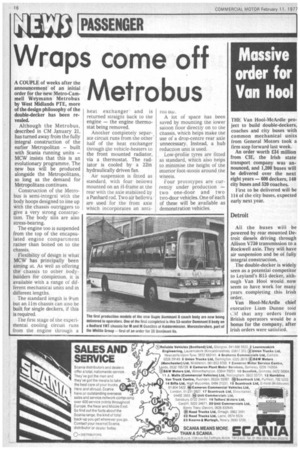Wraps come off Metrobus
Page 18

If you've noticed an error in this article please click here to report it so we can fix it.
A COUPLE of weeks after the announcement of an initial order for the new Metro-Cam mell Weymann Metrobus by West Midlands PTE, more of the design philosophy of the double-decker has been revealed.
Although the Metrobus, described in CM January 21, has turned away from the fully integral construction of the earlier Metropolitan — built with Scania running units — MCW insists that this is an evolutionary programme. The new bus will be produced alongside the Metropolitans, so long as the demand for Metropolitans continues.
Construction of the Metrobus is semi-integral with the body hoops designed to line up with the chassis outriggers to give a very strong construction. The body siiis are also stress-bearing.
The engine too is suspended from the top of the encapsu iated engine compartment rather than bolted on to the chassis.
Flexibility of design is what MCW has principally been aiming at. As well as offering the chassis to other bodybuilders for completion, it is available with a range of different mechanical units and in different lengths.
The standard length is 91/2m but an I Im chassis can also be built for single deckers, if this is required.
The first stage of the experimentai cooling circuit runs from the engine through a heat exchanger and is returned straight back to the engine — the engine thermostat being removed.
Another completely separate circuit runs from the other half of the heat exchanger through the vehicle-heaters to the front mounted radiator, via a thermostat. The radiator is cooled by a 22in hydraulically driven fan.
Air suspension is fitted as standard, with four 'bellows mounted on an H-frame at the rear with the axle stabilised by a Pan hard rod. Two air bellows are used for the front axle which incorporates an anti roil oat.
A iot of space has been saved by mounting the iower saioon floor directiy on to the chassis, which heips make the use of a drop-centre rear axle unnecessary. Instead, a hub reduction unit is used.
Low-profile tyres are fitted as standard, which also helps 1.0 minimise the height of the interior foot-stools around the wheels.
Four prototypes are currently under production — two one-door and two two-door vehicles. One of each of these will be available as demonstration vehicles.
























































































































